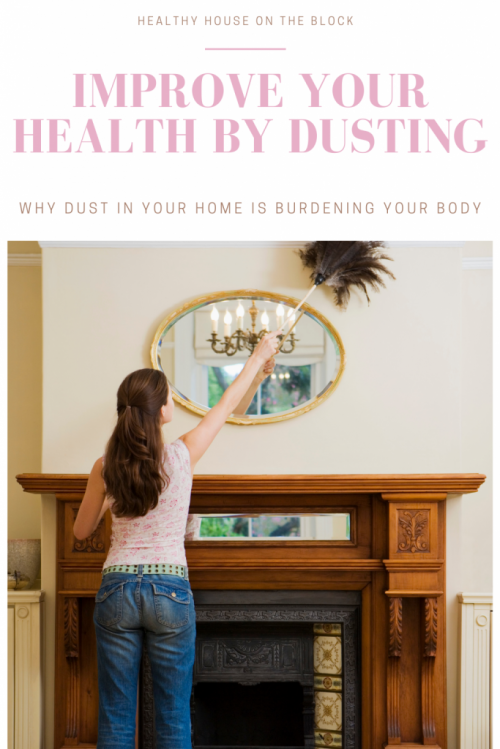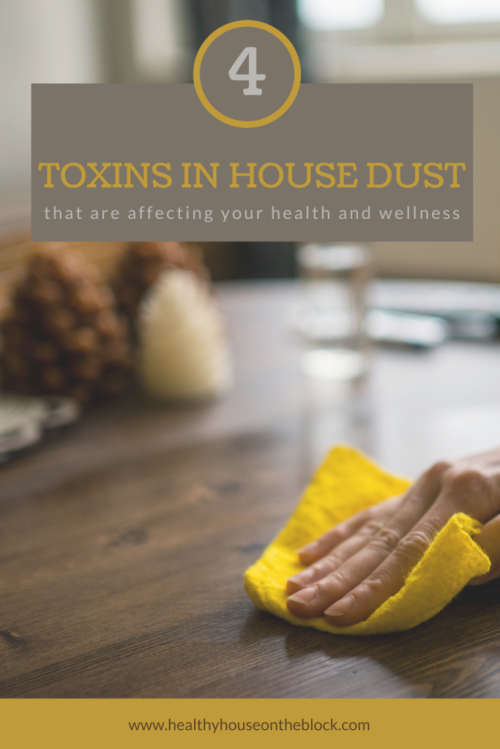
Can I be completely honest with you? I absolutely HATE dust. But if I’m going to be even more honest with you….I hate dusting EVEN more. It’s the chore that gets pushed from one day to the next for a good week sometimes. I’ve figured out that with my kids home this summer the dusting gets done on a more frequent basis. It’s one of my favorite chores to pawn off on them. Plus they love using my DIY dusting spray and I like that they’re preventing dust mites and other toxins from sticking around in our house. It’s really a win-win when the kids dust — right?!
One of the early things I learned when creating my healthy home was that dust is more than just an annoyance and eyesore. Dust is actually one of the places that not only houses dust mites, but it’s a place that contains a variety of different toxins, bacteria and viruses. Not to mention it’s made of dander, dirt and dead skin cells, which is just kind of gross to be keeping in your house.
And so one of the ways that I love to encourage families to create a healthier living space is by creating a really good dusting and vacuuming routine. It’s one of the simple, free ways that you can reduce toxins inside your home. And while it’s a no-frills approach to toxin removal it is probably one of the most effective ways you can reduce toxin exposure at home.
Healthy habits like dusting and vacuuming to remove toxic house dust paired with buying healthier products is the BEST way I know how to create a healthy home environment and it’s exactly what I teach the families I work with.
In this post I’m going to share with you not only why house dust is so harmful to your health, but I’m also going to share with you some ways that you can reduce dust inside. And of course I’m going to be giving you tips on the RIGHT way to dust to make sure you’re removing it and not pushing it around (Hello DIY dusting spray).

DUST & DUST MITES ARE AFFECTING YOUR HEALTH
Chemicals: Dust also contains fibers from carpets and upholstered furniture. It’s safe to say that yes, the chemicals used in carpets and within upholstered furniture are also within the house dust found in living spaces. This means a variety of toxins that we’ve brought into our home stick around in our indoor house dust.
Veena Singla, at NRDC.org published an incredibly in-depth look at exactly what chemicals are found within the dust in our homes. She lists out flame retardants (from furniture), phthalates (from soft plastics and vinyls), PFCs (from stain repellents in carpets), Formaldehyde and Environmental Phenols (from cleaning products) just to name a few.
These chemicals have been labeled as carcinogenic, endocrine and hormone disruptors as well as creating reproductive problems.
Pesticides: Pesticides are all throughout our home. They come in on our shoes and they end up in fine particles that come loose from our furniture, carpet and textiles. Breathing in these fine particles can lead to them becoming deeply embedded into lung tissue where it causes a number of health problems like poor development in children (STUDY), increased risk of cancer, chronic dermal irritation and rashes and immune system deficiencies. (STUDY)

Bacteria: First, it’s important to know HOW the dust enters your home from outdoors. The number one way dirt and dust enter a home from the outdoors is on shoes. Second would be from pets entering the home from outdoors and third would be blowing in from windows and doors and through natural ventilation of the home.
Knowing that most dirt and bacteria come in on shoes means that this problem can be largely corrected by leaving shoes in a foyer or outdoors. A no-shoe policy can minimize the amount of bacteria that enters your home.
The bacteria entering the home from outdoors includes Staphylococcus and Streptococcus species as well as fungal strains of microbes as stated by the BMC Microbiology 2008 Study.
Dust Mites: Dust mites aggravate allergies and an allergic response in most individuals. IN fact, even when dust mites are dead, they still aggravate the same symptoms. The real way to eliminate this problem is to get rid of dust mites altogether.
Dust Mites like a humid environment, and so reducing the humidity levels in your home to be about 35% – 40% is ideal. You also want to make sure you wash drapery and bedding frequently to eliminate any dust build up in these textiles.

KIDS ARE THE HIGHEST RISK GROUP
As a mom, I’ll be completely honest with you: Toxins that affect my kids and their health are usually MUCH more important to me to get rid of first. This is exactly why dust and dust mites are on the top of my list for removal. Especially with my little guy, Cameron, spending most of his time playing on our floors.
The truth is children and babies not only play on floors where dust tends to settle, but their hand-to-mouth habits also put them at the highest risk for ingesting the problematic components of dust. Toys and other objects often end up in their mouths, allowing them to ingest bacteria and chemicals on a fairly regular basis.
Children who are exposed to higher levels of dust are also at a higher risk for developing asthma and eczema. Dust mites are the large contributing factor when it comes to these problems. A study published in the International Journal of Dermatology breaks down the correlation between the increased cases of childhood eczema and dust mites found indoors.
Childhood Asthma is also on the rise due to many contributing factors. But one factor that can be more controlled than others is by removing the exposure to dust mites within homes. Immunological Reviews published a 2011 study showing early-onset asthma is often linked to an allergic response from dust mites.
These health studies definitely leave me wanting to grab my dusting spray right now and reduce the toxins and chemicals my kids are exposed to as quickly as possible.

HABITS TO PREVENT DUSTING
No Shoes: Removing shoes at the door and creating a no-shoe policy in your own home can help reduce the amount of dust and dirt comes into your house in the first place. Utilizing a rug to help catch the particles before they get tracked around your home is another great idea.
Pets: Wipe off your fur baby’s paws when you come inside and you’ll keep a lot of bacteria and pesticides from being tracked around the house. Keep an old hand towel near the door so you can easily wipe off paws.
Humidity: Dust mites thrive in humid environments. If a home is around 35%-40% humidity, dust mites will not be able to reproduce, therefore eliminating many of them from your home. You can check your indoor humidity with a simple hygrometer or if you have a smart thermostat such as the Nest, you can check on your app.
Scheduled Cleaning: Using a calendar app or a schedule at home can help you reduce dust by simply keeping up with removing it on a regular basis. This means dusting and vacuuming on a regular (weekly) basis and then cleaning tough spots every month or so (ceiling fans, HVAC grates and other hard to access places that collect dust.
Furnace Filters: Replacing the filters within furnace systems and whole house fans is a great way to make sure dust isn’t getting spread throughout your home. I tell my customers to purchase a large box of filters and keep them near the furnace. This way they’re more likely to replace the filters more frequently. NordicPure filters get an A+ in my book for top notch furnace filters.
Duct Cleaning: If you have pets, this routine maintenance is a MUST. Getting your vents cleaned every other year will help keep dust at bay within your home. If you’re moving into a new home, I always recommend you get the ductwork cleaned out before moving your family in. This is especially true if anyone in your family has allergies or asthma.

HOW TO DUST THE RIGHT WAY (PLUS MY DIY DUSTING SPRAY)
Once you’ve got some lifestyle habits in place that will naturally reduce the amount of dust at home, your dusting should get a lot easier. Dusting the right way and actually removing the dust will absolutely help reduce the amount of dust in your home after a week or two.
Dusting Spray: Using a dusting spray will help not only remove the dust that you wipe off, but will also help repel dust from the surface. That means the dust will land either in the carpet or another surface you can easily vacuum.
Dusting Spray Recipe:
- 1 cup water
- 1/4cup white distilled vinegar
- 2 tsp olive oil
- 10 – 15 drops Essential Oil (lemon, wild orange or grapefruit)
- Glass Spray Bottle
- Swedish Cleaning Cloth

Wet Mop: We use a refillable wet mop at our house and clean smooth surface flooring just about every day. It helps to spray the floor (not too much!) as opposed to dry mopping because the liquid traps the dust and dirt instead of pushing it back up into the air again.
Vacuum with a HEPA filter: Most vacuums nowadays have a HEPA filter on them. Using a HEPA filter means you will trap more of the tiny particles that are in the dust instead of pushing them back up into the air. Our family uses the Shark Ion Robot daily and that has REALLY helped with the amount of dust and dirt that’s around our home.
I truly think that one of the BEST and SIMPLEST ways to reduce toxins in the home is through reducing dust in the home. And it doesn’t have to be a hard thing to control. Simply reducing the amount of dust produced in the home through the habit changes will get you a really big head start when it’s time to start dusting and cleaning.
Share this:
- Click to share on Facebook (Opens in new window) Facebook
- Click to share on LinkedIn (Opens in new window) LinkedIn
- Click to share on Reddit (Opens in new window) Reddit
- Click to share on Pinterest (Opens in new window) Pinterest
- Click to print (Opens in new window) Print
- Click to share on X (Opens in new window) X




Pingback: Plastic Free & Toxin Free Organizing Ideas » Healthy House on the Block
Pingback: HEPA Filter Vacuum for a Healthier House » Healthy House on the Block
Pingback: Home Ventilation Habits: Improve Your Indoor Air »
Pingback: Nine Free Ways to Reduce Environmental Toxins at Home
Pingback: Healthy Home Expert: Microbiome Disrupting Chemicals: How to Avoid This New Class of Chemicals
Pingback: How to declutter your home to improve health - Healthy House on the Block
Pingback: 8 Ways to Transform Your Healthy Home & Support Your Health